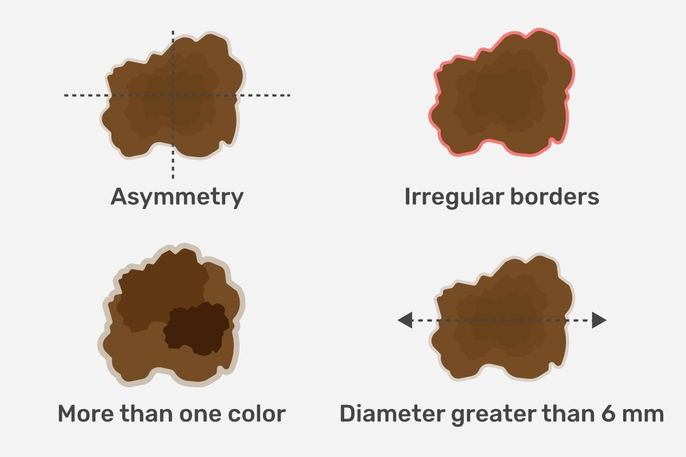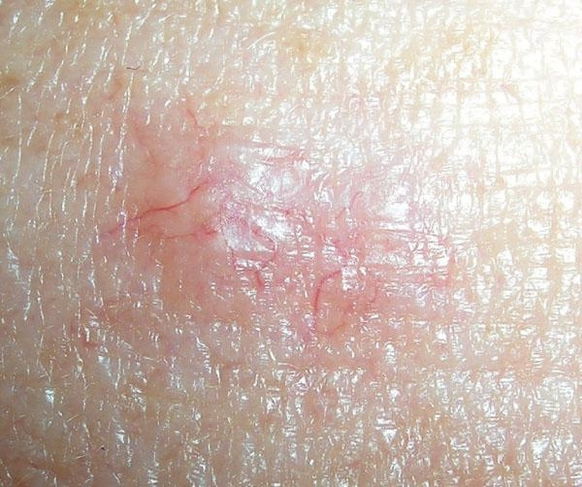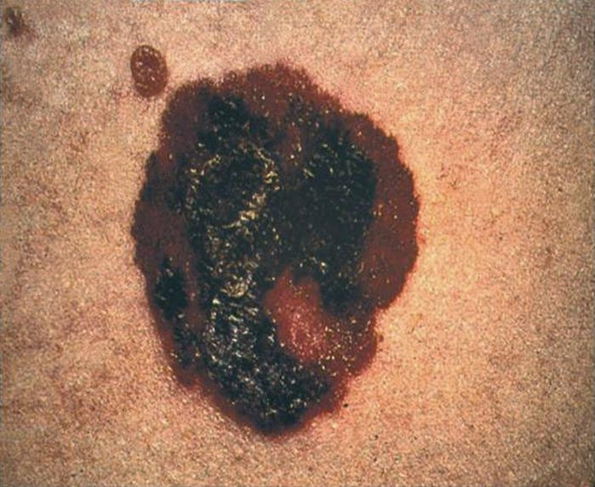Signs of skin cancer include lesions, spots, or moles with characteristics like varying colors, irregular borders, and increased growth over time.
These characteristics may be observed by the individual themselves or by a partner or family member if the lesion is located on the back or another area that is difficult to see. Routine skin checks can help with early detection of potentially cancerous lesions.
A diagnosis of melanoma or nonmelanoma skin cancer requires a physical exam with a dermatologist and a biopsy to confirm whether a lesion is cancerous. Only then can a dermatologist confirm a diagnosis and recommend the most appropriate treatment.

Common characteristics
The ABCDE skin assessment is a helpful tool to identify signs of skin cancer.
The five main characteristics to help identify skin cancer are:
- A (Asymmetry): if half of the spot is different than the other. An asymmetrical mole can be a sign of skin cancer;
- B (Borders): when the borders of the spot are irregular;
- C (Color): if the mole or spot has more than one color, such as black, brown, or red;
- D (Diameter): if the mole or spot is greater than 6 mm (0.25 inches) in diameter;
- E (Evolving): if the mole, spot, or skin lesion is changing over time (in size, color, or shape, for example).
To better identify any skin changes, it is recommended to check the body from head to toe in front of a mirror, including the back, behind the ears, and the head. Skin checks should be done monthly, or as often as advised by your dermatologist.
Be on the lookout for spots, blemishes, or moles that are irregular or have changed in size, shape, or color. It is also important to make note of any cuts or wounds that have not healed completely after more than a month.
It can be helpful to have another person help you with a skin check, especially for areas like the scalp that may be difficult for you to see. You can also take pictures of any larger moles, spots, or lesions to help you observe any changes over time.
It is important to consult a dermatologist for any concerning moles, spots, or lesions that could be signs of skin cancer. A dermatologist can perform a thorough skin exam and order additional tests if necessary.
Additional signs
While the majority of cases of skin cancer present with the above characteristics, other signs can also indicate cancer. These signs vary based on the type of skin cancer present and include:
1. Signs of nonmelanoma skin cancer

Signs of nonmelanoma skin cancer include:
- A small wound or nodule on the skin that may cause itching and can be white, red, or pink in color;
- A wound or nodule that grows rapidly and forms a raised lesion that can itch and ooze;
- A wound that does not heal and bleeds for several weeks;
- A wart that grows in size.
Basal cell carcinoma and squamous cell carcinoma are two of the most common types of nonmelanoma skin cancer that are less serious and easier to treat. However, squamous cell cancer that is diagnosed at an advanced stage can, in some cases, spread to other organs of the body.
2. Signs of melanoma skin cancer

Signs of melanoma can include a mole that is dark in color, with irregular borders, and accompanied by symptoms like itching and peeling of the skin.
Malignant melanoma is the most dangerous type of skin cancer, and can cause changes to an existing mole like changes in shape, color, or size.
The main cause of melanoma is prolonged sun exposure, making it important to apply sunscreen every day and avoid spending too much time in the sun.
Also recommended: What Melanoma Looks Like (with Pictures): 5 Signs tuasaude.com/en/what-melanoma-looks-likeWhen to see a doctor
It is recommended to see a dermatologist whenever you notice a change in a mole or spot on your skin.
The majority of these cases will not be cancer, however your dermatologist may recommend regular appointments to observe for any further changes. They may even choose to surgically remove the mole or lesion if it appears precancerous or there is a concern for malignancy.
Confirming a diagnosis
The diagnosis of skin cancer is made by a dermatologist or oncologist, and includes a detailed examination using a special magnifying glass to observe the characteristics of the mole or spot, including the shape, size, color, and diameter of the lesion.
If cancer is suspected, your provider will likely perform a skin biopsy and arrange for other tests as necessary. If a diagnosis of skin cancer is confirmed, treatment may involve surgery, radiation, chemotherapy, immunotherapy, or targeted therapy.
For noncancerous lesions, your provider may recommend other treatments like the use of topical or oral medications.
Prevention strategies
Certain precautions can be taken to help prevent the development of skin cancer. These include:
1. Protecting the skin
To help protect the skin from UV rays, avoid sun exposure during the hottest times of day, which are typically between 11AM and 4PM (especially in the summer). Stay in the shade as much as possible. In addition, it is important to:
- Wear a wide-brimmed hat;
- Wear light-colored clothing made from cotton, or sun protective clothing with a symbol saying SPF 50+;
- Wear dark glasses with UV protection that can be purchased at optical stores;
- Use sunscreen.
These tips should be followed whether at the beach, the pool, or engaging in outdoor activities like exercising, gardening, or working outdoors.
2. Using sunscreen
For protection against UVA and UVB rays, it is important to apply sunscreen with an SPF of 30 or higher every day. Apply all over your body, including your face, feet, hands, ears, and neck. Make sure to reapply every 2 hours or after going in the water.
It is important to use sunscreen all year round, including during the winter. This is because UV radiation passes through the clouds even when it is overcast, having a negative effect on unprotected skin.
3. Performing regular skin checks
Perform a skin self-check at least once a month (or as recommended by your dermatologist) to observe for moles or spots that have changed in color, have irregular borders, or have increased in size.
It is also important to schedule a routine dermatology appointment at least once a year (or as recommended by your dermatologist) for a full body skin exam. This can help with early detection of cancerous and precancerous lesions.
4. Avoiding tanning beds
Using artificial tanning beds increases the risk for skin cancer due to intense exposure to UVA and UVB rays that tan the skin quickly but increase the risk for cellular changes that can lead to cancer.






























